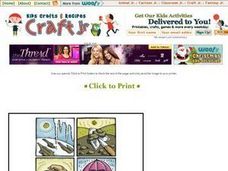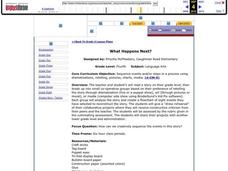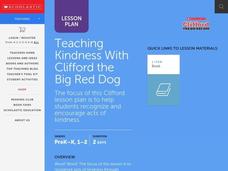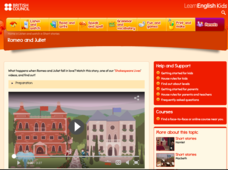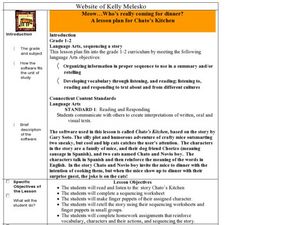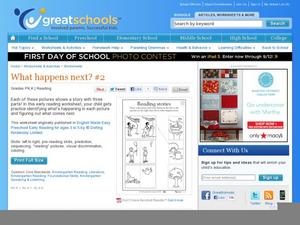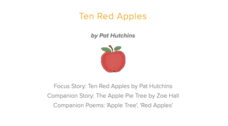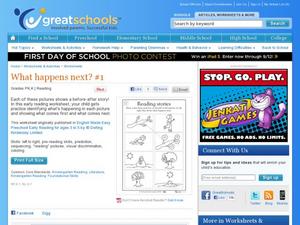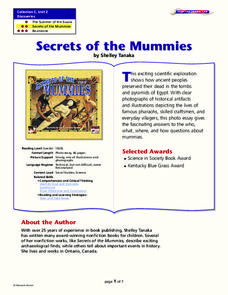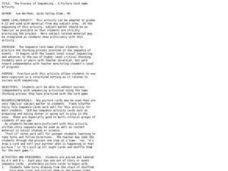Florida Center for Reading Research
Comprehension: Narrative Text Structure, Story Pieces
An activity boosts reading comprehension by challenging scholars to answer questions about a narrative tale detailing elements—plot, characters, setting, theme, problem, and solution.
Student Handouts
Beginning-Middle-End Chart
Track the plot of a book with a straightforward chart. Pupils write in the title of the book and then note down what happened at the beginning, middle, and end of the story.
Do2Learn
Book Report
Tackle the basics of plot with a straightforward book report form. Learners note down the author and title, setting, characters, and basic plot points in any story or book.
Curated OER
Picture Story: How Do Plants Grow
In this picture story: how do plants grow worksheet, students look at eight pictures about the growth of a plant and decide what sequence to put them in.
Curated OER
Three Little Pigs Story Comparison
First graders identify the characteristics of a fairy tale and share a fairy tale they are familiar with. They are read a story that is similiar to the "Three Little Pigs" noting the differences between the original and this story. ...
Curated OER
What Happens Next?
Fifth graders complete activities to help them sequence events in a story. In this sequencing lesson, 5th graders read a story and work in groups to retell the story by creating a flowchart of events to reconstruct. Students create their...
Curated OER
Be Kind
Students express feelings and learn about kindness. In this social skills lesson, students read Clifford Wants a Cookie and retell the story in sequence by using pictures. Students create a sweet treat for someone that has shown them...
British Council
Romeo and Juliet
An engaging video featuring William Shakespeare's Romeo and Juliet is accompanied by six activities designed to reinforce vocabulary, story elements, and comprehension. Scholars match words to pictures, place events in sequential order,...
Louisiana Department of Education
Out of the Dust
The Grapes of Wrath may be the most famous novel set during the Dust Bowl, but what other stories cover the same time? The unit focuses on the Karen Hesse novel Out of the Dust. Learners keep a timeline of the Dust Bowl, maintain a...
Curated OER
The Magic Pot
In this reading comprehension lesson, students use the book "The Magic Pot," to explore many concepts including; story elements, sequencing, and phonics. Students also practice making doubles using coins and "magic pots." This very...
Curated OER
Sequencing: Beginning, Middle, End
In this sequencing worksheet, students draw 3 pictures, showing the beginning, middle and end of a stories about making pizza and getting ready for school.
Curated OER
Pumpkin Carving Sequencer
Students arrange illustrations in sequential order. In this text organization lesson, students access a webpage where they must follow the instructions to learn about the steps of pumpkin carving. Students then click and drag...
Curated OER
Sequence and Retell - The Napping House
Students sequence the story The Napping House by keeping trace of the characters in order. In this sequencing lesson plan, students also retell the story as they sequence.
Pennsylvania Department of Education
Tell Me A Story
Students listen to the story Mrs. Wishy Washy and practice retelling the story. For this tell me a story lesson, students become familiar with all of the characters in the story, then use character pieces to retell the story. Students...
Curated OER
Lesson Plan for Chato's Kitchen
Through an exploration of Chato's Kitchen by Gary Soto, learners practice sequencing skills, retelling a story, and Spanish vocabulary words. All of the necessary resources, worksheets, and other materials are provided in order to give...
Curated OER
What Happens Next: 2
What happens next? That is a great question that requires learners to think about the sequence of events then make a prediction. They assess the pictures on the left and draw lines to the pictures on the right that show what will happen...
Curated OER
The Three Little Pigs
Kindergarteners are presented with three types of materials: real straw, sticks, and a real brick and make prior knowledge connections as it relates to the story of The Three Little Pigs. They listen to the story and work together to...
Curated OER
Ten Red Apples; The Five Senses
A clever lesson designed around an apple awaits your learners. Descriptive words are used to explain what they believe is inside a bag while using their five senses. Learners read the story The Apple Pie Tree and are introduced to the...
Curated OER
What Happens Next? 1
Knowing how to sequence events means you have to know what happens before and after. Little ones draw a line from four before images to the images that show what happened next. This is a good challenge for your youngest learners.
August House
How Tiger Got His Stripes
How did the tiger get its stripes? Kindergartners read a Vietnamese folk tale, "How the Tiger Got His Stripes," retold by Rob Cleveland, and work through several reading comprehension and literary analysis activities.
Curated OER
Secrets of the Mummies
How did the ancient people of Egypt preserve their dead so well that their bodies are still recognizable today? Learn the painstakingly complex process they used for preservation. Young scholars read and summarize a narrative detailing...
Curated OER
The Process of Sequencing- A Picture Card Game Activity
Students put the events of a story in the correct order. In this sequencing lesson, students are paired up and labeled A or B. Students in each group receive a set of story or event sequence cards and they take turns drawing...
Curated OER
The Process of Sequencing - A Picture Card Game
Learners play a picture card game where they have to sequence the pictures in the correct order. In this sequencing lesson plan, students can do this for any subject.
Curated OER
Comprehension: Understanding "sequence"
Second graders read the story The Broken Bed and then sequence the story in their own words. In this sequencing lesson plan, 2nd graders also write narrative with a specific beginning, middle, and end.





